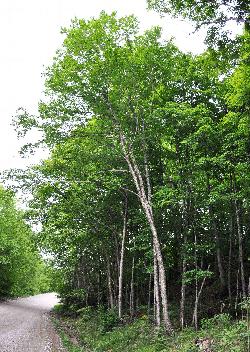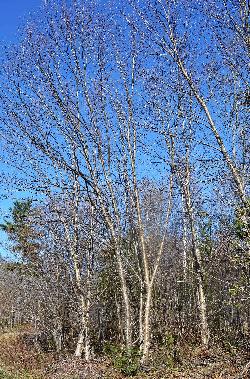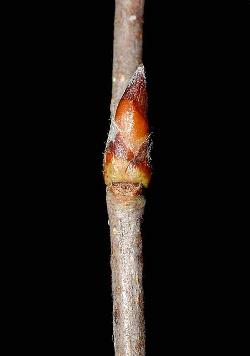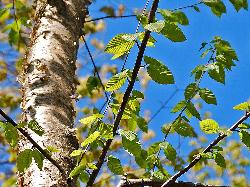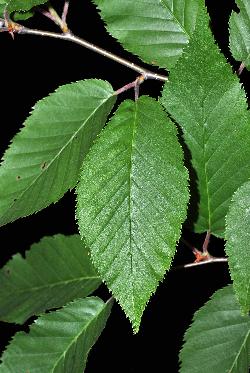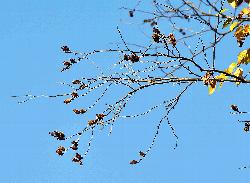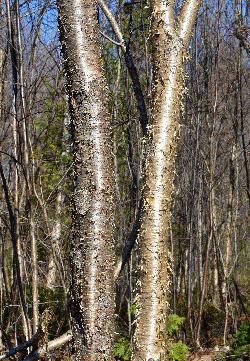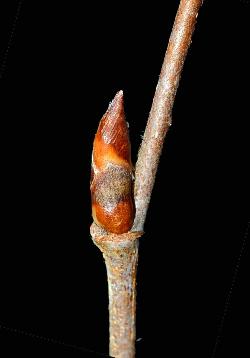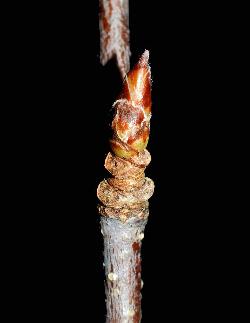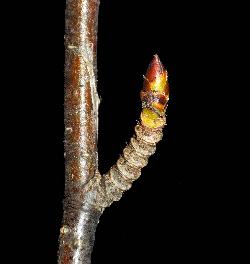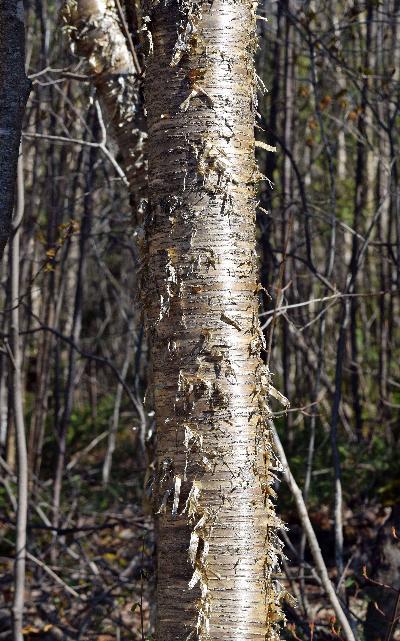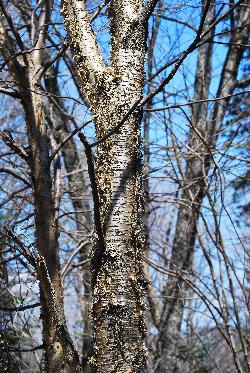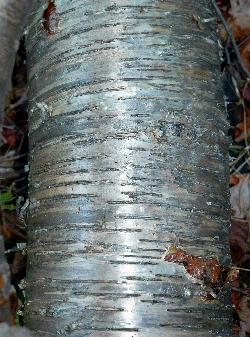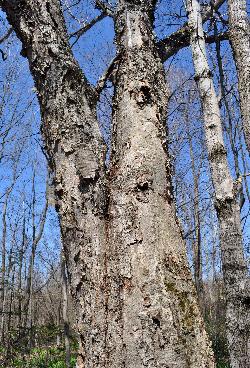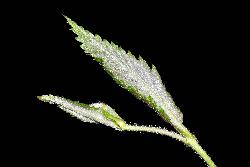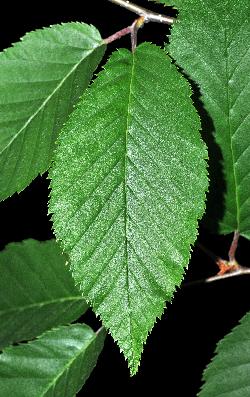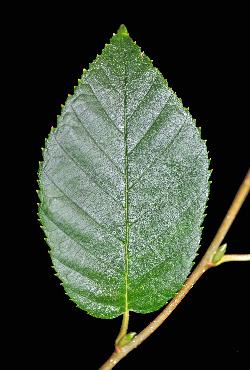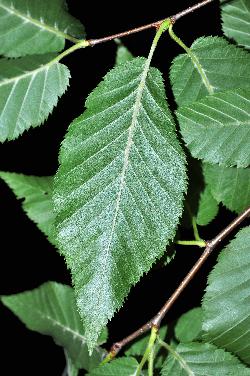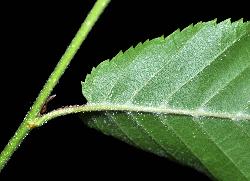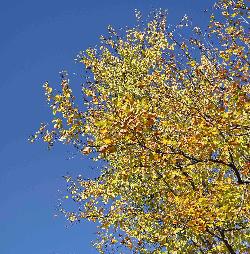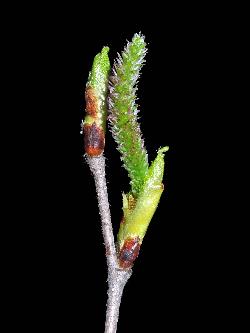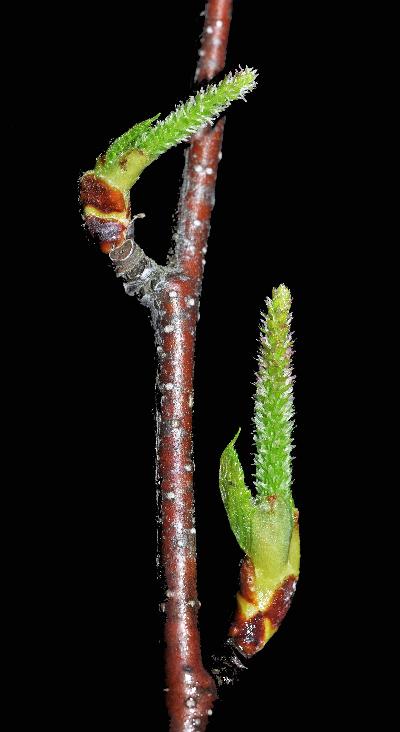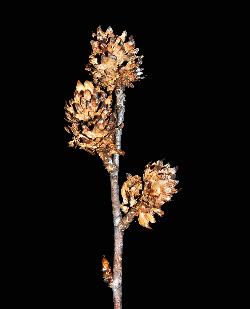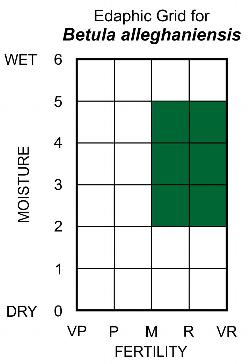Fr: bouleau jaune, bouleau des Alléghanys, merisier
Betulaceae - Birch Family
Note: Numbers provided in square brackets in the text refer to the image presented above; image numbers are displayed to the lower left of each image.
General: A medium-sized deciduous tree with wide-spreading branches [1–2]; yellow birch grows to 23–25 m tall, with an average d.b.h. of 60 cm, and is long-lived, to 150+ years. Yellow birch is slow-growing, of intermediate shade tolerance, and shallow-rooted, but its wide-spreading roots make it windfirm in deep soils (Farrar 1995, Erdmann 1990). Within the Province, yellow birch occurs only in southern Newfoundland. It is known locally as witch hazel, due to its irregularly branched crown [3], but yellow birch is not related to Hamamelis virginiana L., known in mainland Canada and the United States as witch hazel, and which has a range that extends from Nova Scotia southwest to Texas.
Newfoundland populations of yellow birch belong to var. macrolepis (Fernald) Brayshaw [3], originally described from New England specimens, as B. lutea Michx. var. macrolepis by M.L. Fernald (1922). In Gray’s Manual, Fernald noted that Newfoundland populations have foliaceous pistillate bracts that measured 8–13 mm long, with an "elongate basal portion 2.5–6 mm long," (Fernald 1970), while the typical mainland yellow birch has subcoriaceous pistillate bracts that are 5–8 mm long, with a basal portion 1–2.5 mm long (Fernald 1922). Both var. lutea and var. macrolepis occur on the mainland.
Key Features:
- Twigs have a distinct wintergreen flavour when chewed; buds are pointed (acute to acuminate), with 5–7 two-toned bud scales [4].
- Leaves are ovate to obovate, usually with 12–18 pairs of secondary veins, but may have as few as 9 pairs; the secondary veins often branch near the margins, with smaller veins extending into the marginal teeth [5–6].
- The fruiting catkins are erect, ovoid, and persist on the tree after the fruits have been shed [7]; the wings of the fruit are narrower than the body of the nutlet. Pistillate scales of Newfoundland yellow birch catkins are 8–13 mm long, longer than pistillate scales of yellow birch from the mainland, which are 5–8 mm long.
- The shiny bark of mature yellow birch trees is silvery-gray, yellowish, or bronzy, and separates in very thin narrow curly strips [8].
Stems/twigs: Twigs are brown, sparsely pubescent to glabrous at maturity, with scattered resin glands and few lenticels. Yellow birch twigs have a distinct wintergreen flavour when chewed. Birch trees have two types of shoots: long shoots and spur shoots. In yellow birch, long shoots are new terminal growth with alternate lateral buds that are 5–7 mm long, sharply pointed (acute to acuminate), often pubescent, and have three 2-toned yellowish-brown to brown bud scales [9]. Spur shoots are lateral shoots that occur on year-old or older twigs and bear a single ovoid sharply pointed (acuminate) pseudoterminal bud with 5–7 bud scales [10–11]. Leaf scars are elliptic with 3 bundle trace scars [12]. The bark on young trees and branches is dark reddish-brown and glabrous with small pale lenticels. Mature trees have lustrous silvery-grey, yellowish, to bronze outer bark that exfoliates in narrow horizontal paper-thin curling strips, giving the trunk a shaggy appearance [13–14]; the inner bark has a wintergreen fragrance. Lenticels are horizontal, long, and narrow [15]. Older trees have reddish-brown to greyish-brown scaly bark [16].
Leaves: Alternate, simple, pinnately-veined, and short-petiolate. Leaves are elliptic to ovate, densely pubescent when young [17], 6–11 cm long by 3–5.5 cm wide, and usually have 12–18 pairs of secondary veins [18], although there may be as few as 9 or 10 pairs [19]. On mature leaves, the upper surface is dull and glabrous; the lower surface is slightly paler, with tufts of hairs along the veins and in the vein axils [20–21]. The apex is sharply pointed (acuminate), the base is rounded to slightly cordate. Leaf margins are coarsely double-serrate (biserrate), with 2–3 smaller teeth between larger teeth; the secondary veins often branch near the margins, with 2–4 smaller tertiary veins extending into the marginal teeth [21]. Long shoots bear several alternate leaves, while spur shoots typically bear only 2 leaves [22]. In autumn, leaves turn golden yellow [23].
Flowers: Unisexual; trees are monoecious, with separate male and female catkins on the same tree and branch. Birch catkins have dense spirals of small flowers subtended by a 3-lobed bract; sepals and petals are lacking. Male flowers occur in 3–6 catkins, initially about 2.5 cm long, located near the ends of long shoots [24], soon becoming pendant and expanding to 8 cm long when shedding pollen [25]. Each bract (staminate scale) of the male catkin subtends 3 flowers, each with 3 stamens. Pollination is by wind (anemophily). Female flowers are numerous in erect, cylindrical to ovoid catkins, to 2 cm long [26-27], and emerge with the leaves from lateral buds and spur shoot buds on the same twigs as the male catkins [28]. Each 3-lobed bract (pistillate scale) subtends 2–3 female flowers, each composed of a single pistil with a 2-carpelled inferior ovary and 2 stigmas.
Fruit: Fruiting catkins are erect, ovoid, 1.5–3 cm long by 1–2.5 cm wide [29], composed of numerous small bracts (pistillate scales), which subtend the small fruit (winged nutlets). The nutlets are 1.5–2.5 mm long, with thin papery wings that are narrower than the body of the nutlet. The nutlets are each subtended by a 3-lobed, ciliate-margined pistillate scale, 8–13 mm long in Newfoundland plants, with a narrow tapering central lobe, and 2 ascending, slightly shorter lateral lobes. Fruiting catkins are persistent on twigs after the nutlets are shed [7], often remaining on the branches over winter. Dispersal of fruit and seeds is by wind (anemochory).
Ecology and Habitat: Yellow birch is a decidedly southern species in Newfoundland and the eastern boreal forest, where it is used as an indicator of the "hemi-boreal" transition to temperate forests. Yellow birch is absent from Labrador; on the Island, it occurs as an associate in balsam fir-white birch forests on moist, nutrient-rich slopes in the Western, Maritime Barrens, and Avalon Ecoregions (Damman 1983). Like white birch, it is a pioneer species that can be abundant in early seral stages after fire or cutting where there is sufficient scarification to create suitable seedbeds and reduce competition from other species.
Edaphic Grid: See image [30]: the Edaphic Grid for Betula alleghaniensis.
Forest Types: Yellow birch reaches its greatest frequency and abundance in the following forest types:
- Abietum dryopteretosum (Dryopteris-Balsam Fir Forest Subassociation)
- Aceretum galietosum (Galium-Mountain Maple Thicket Subassociation)
- Alnetum dryopteretosum (Dryopteris-Alder Swamp Subassociation)
- Betuletum dryopteretosum (Dryopteris-Birch Forest Subassociation)
- Betuletum rubetosum (Rubus-Birch Forest Subassociation)
Yellow birch can also occur sporadically in the Abietum hylocomietosum (Hylocomium-Balsam Fir Forest Subassociation) in southern Newfoundland.
Succession: Yellow birch is a pioneer species of intermediate shade tolerance that rarely attains dominance in boreal forest stands. Under natural conditions, it requires disturbance from fire or blowdown to successfully establish on mineral soil seedbeds. After cutting, it usually establishes on skid trails and other areas that are heavily scarified. Seedlings rarely survive where there is deep humus or if they are smothered by accumulations of hardwood leaves or other herbaceous material.
Distribution: On the Island of Newfoundland, yellow birch is restricted to western Newfoundland and the forested river valleys of the south coast and Avalon Peninsula [3]; it is absent from Labrador. Elsewhere in North America, yellow birch occurs from Nova Scotia west to northeastern Ontario, and the southern border of northwestern Ontario and southeastern Manitoba. In the United States, its range extends from Maine west to Minnesota and south along the Appalachian Mountains to eastern Tennessee, western Kentucky, and northeastern Georgia (Erdmann 1990).
Similar Species: White birch (Betula papyrifera Marshall) can be differentiated from yellow birch by its chalky-white bark that exfoliates in sheets. Also, white birch leaves have 6–9 pairs of secondary veins in their ovate leaves, which are widest at the base. Heartleaf birch (Betula cordifolia Regel) can be recognized by its off-white to bronze-tinged bark that exfoliates in thin strips, and usually has leaves with 9–12 pairs of secondary veins. Both white and heartleaf birch have pendant cylindrical fruiting catkins, while yellow birch has erect ovoid fruiting catkins. Also lacking in white and heartleaf birch is the distinct wintergreen flavour of the twigs when chewed, which is characteristic of yellow birch twigs.


